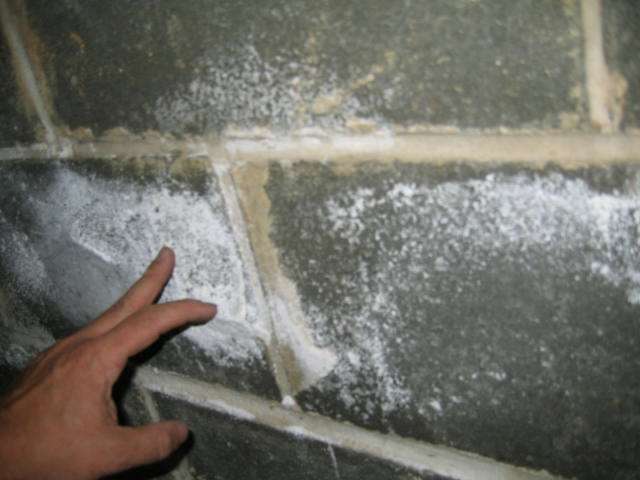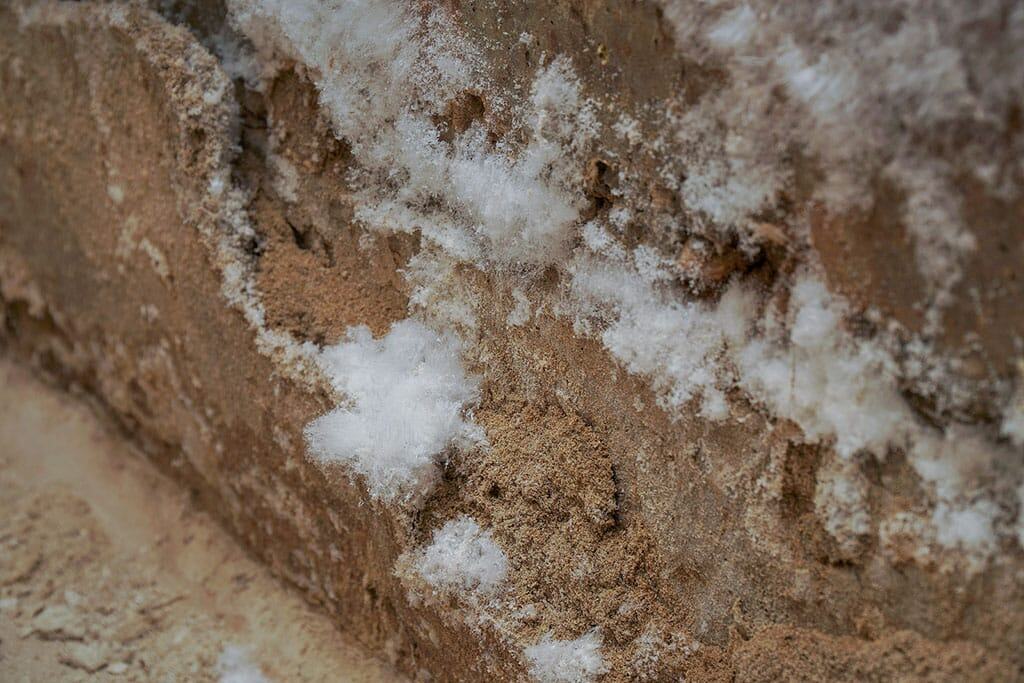What Is The White Powdery Substance On My Basement Wall?
If you’re a homeowner in Toronto or the Greater Toronto Area, you’re probably familiar with that distinctive musty odor that can develop in your basement. It’s a common problem that many residents face, especially given our region’s climate with its humid summers, freeze-thaw cycles, and significant precipitation throughout the year. That unpleasant smell isn’t just a nuisance—it’s often a warning sign that something needs your attention.
When you notice a musty smell in your basement, you might also observe white, chalky deposits on your concrete walls or what appears to be white, fuzzy growth. But here’s where many homeowners get confused: these two very different issues can look surprisingly similar at first glance. Understanding whether you’re dealing with efflorescence or white mold is crucial for taking the right action to protect your home and your family’s health.
In this guide, we’ll help you identify what’s causing that musty smell, explain the difference between efflorescence and white mold, and provide you with the information you need to address the problem effectively.
Understanding Musty Basement Smells in Toronto Homes
That characteristic musty odor in your basement is typically caused by excess moisture and poor ventilation. In the GTA, our basements are particularly vulnerable due to several local factors. Toronto’s clay soil content makes drainage challenging, our older housing stock often has foundation issues, and the dramatic temperature swings between seasons create the perfect conditions for moisture problems.
Common Causes of Basement Moisture
The musty smell you’re detecting is often the result of one or more moisture sources:
- High humidity levels: Toronto summers can be quite humid, and basements naturally tend to be cooler, causing condensation
- Water seepage: Groundwater infiltration through foundation cracks or poor exterior drainage
- Plumbing leaks: Undetected leaks from pipes, water heaters, or washing machines
- Poor ventilation: Inadequate air circulation trapping moisture inside
- Flooding events: Toronto experiences occasional heavy rainfall and spring snowmelt that can overwhelm drainage systems
When moisture combines with organic materials found in basements—such as wood, drywall, cardboard, or fabrics—it creates an ideal environment for mold growth and bacterial activity. This biological activity is what produces that telltale musty odor.

What Is Efflorescence and Is It Harmful?
When you spot white, powdery deposits on your basement walls, your first instinct might be to worry about mold. However, you could be looking at efflorescence—a completely different phenomenon that, while indicating a moisture issue, isn’t a health hazard itself.
Understanding Efflorescence
Efflorescence occurs when water moves through concrete, brick, or masonry materials and brings dissolved salts to the surface. As the water evaporates, it leaves behind white, chalky, crystalline deposits. This is a common occurrence in Toronto basements, particularly in older homes built with traditional masonry foundations.
The process works like this: water enters the porous concrete or masonry (often from outside soil moisture or groundwater), dissolves mineral salts present in the building materials, travels through the material via capillary action, and evaporates at the surface, leaving salt crystals behind.
Is Efflorescence Dangerous?
The good news is that efflorescence itself is not harmful to your health. These salt deposits are inert minerals that don’t produce spores or toxins. You won’t experience respiratory issues, allergic reactions, or other health problems from efflorescence alone.
However, efflorescence is a clear indicator that water is penetrating your foundation, which can lead to several concerns:
- Structural deterioration: Repeated water infiltration and salt crystallization can gradually weaken concrete and masonry
- Ideal conditions for mold: The moisture that causes efflorescence also creates perfect conditions for mold growth
- Foundation damage: In Toronto’s freeze-thaw climate, water in foundation cracks can freeze and expand, causing progressive damage
- Basement flooding risk: Poor drainage that allows water penetration can eventually lead to more serious water intrusion
While efflorescence won’t make you sick, it’s a symptom of a moisture problem that requires attention to prevent more serious issues down the line.
White Mold: What You Need to Know
Unlike efflorescence, white mold is a living organism that can pose real health risks. It’s one of several mold types that can grow in damp basement environments throughout the GTA, and it deserves your immediate attention.
Identifying White Mold
White mold is a type of fungus that appears fuzzy or fibrous, unlike the flat, crystalline appearance of efflorescence. It typically grows on organic materials such as wood framing, drywall paper backing, ceiling tiles, cardboard boxes, fabrics, and stored items. In Toronto basements, white mold commonly develops on rim joists, exposed wood beams, and along the bottom of drywall where it meets concrete floors.
Health Concerns Associated With Mold
White mold, like other mold varieties, can cause various health issues, particularly for sensitive individuals. According to Health Canada guidelines and Ontario health regulations, mold exposure can lead to respiratory symptoms including coughing, wheezing, and nasal congestion, allergic reactions such as sneezing, runny nose, red eyes, and skin rashes, asthma attacks in people with asthma, and headaches and fatigue in some individuals.
Children, elderly individuals, people with respiratory conditions, and those with compromised immune systems are particularly vulnerable to mold-related health effects. Given that basements are often used as living spaces, playrooms, or home offices in Toronto homes, addressing mold quickly is essential for maintaining a healthy indoor environment.
Why White Mold Thrives in Toronto Basements
Our local climate creates ideal conditions for mold growth. Toronto’s humidity levels, especially during summer months, combined with cool basement temperatures, provide the moisture mold needs to flourish. Spring flooding from snowmelt, poor ventilation in finished basements, and water infiltration through older foundations all contribute to mold problems in GTA homes.
How to Tell the Difference: Efflorescence vs. White Mold
Since efflorescence and white mold can look similar to the untrained eye, here are some practical tests you can perform to help identify what you’re dealing with:
Visual Inspection Techniques
Texture Test: Efflorescence has a powdery, crystalline texture that feels gritty when rubbed between your fingers, similar to salt or sand. White mold, on the other hand, appears fuzzy, fluffy, or fibrous with a three-dimensional structure.
Location Check: Efflorescence only appears on masonry surfaces—concrete, brick, or stone. It cannot grow on wood, drywall paper, or fabric. White mold grows on organic materials and is commonly found on wood framing, drywall, insulation, and stored items.
Water Test: Try spraying a small amount of water on the white substance. Efflorescence will dissolve and disappear because it’s made of water-soluble salts. White mold will not dissolve in water and may appear darker when wet.
Vinegar Test: Place a few drops of vinegar on the substance. Efflorescence will fizz due to its mineral composition. Mold will not react to vinegar.
When Visual Identification Isn’t Enough
Sometimes the distinction isn’t clear-cut. You might have both efflorescence and mold present in your basement, or the growth pattern might be ambiguous. Additionally, other mold colors like light gray or beige can be mistaken for white mold, and some mold species can appear white in early stages before developing other colors.
In these situations, it’s important to remember that attempting to identify mold types on your own has limitations. Without proper testing, you can’t determine the specific mold species or spore concentration levels. Some mold types are more hazardous than others, and DIY identification can miss hidden mold growth behind walls or under flooring materials.
Professional Solutions: When to Call a Restoration Company
Given the potential health risks and structural concerns associated with basement mold, professional assessment is often the wisest choice—particularly if you’re uncertain about what you’re dealing with.
The Benefits of Professional Mold Inspection
A qualified restoration company in Toronto can provide comprehensive services that go beyond simple visual identification. Professional mold inspectors use moisture meters to detect hidden water sources, thermal imaging cameras to identify temperature anomalies indicating moisture, air quality testing to measure spore levels, and surface sampling to identify specific mold species.
For Toronto homeowners, professional inspection is especially valuable because local building codes and insurance requirements often mandate proper documentation of mold issues. The Ontario Building Code has specific requirements for moisture control and remediation, and having professional assessment reports can be crucial for insurance claims related to water or mold damage.
What Professional Mold Remediation Involves
If mold is confirmed, professional remediation follows industry standards and includes containment procedures to prevent spore spread, proper removal techniques that don’t just clean surface mold but address the root cause, moisture source identification and elimination, and HEPA air filtration during the remediation process. A reputable restoration company will also verify that the mold has been successfully removed through post-remediation testing.
Addressing Efflorescence Problems
If your white deposits turn out to be efflorescence rather than mold, a professional restoration company can still help by identifying the moisture source causing water infiltration, recommending drainage improvements or waterproofing solutions, repairing foundation cracks or defects, and improving basement ventilation to reduce humidity levels.
Taking Action: Protecting Your Toronto Home
Whether you’re dealing with efflorescence, white mold, or simply that persistent musty smell, taking action sooner rather than later protects both your property investment and your family’s health.
Immediate Steps You Can Take
While waiting for professional assessment, you can improve your basement environment by running a dehumidifier to maintain humidity below 50 percent, improving ventilation by opening windows when weather permits, fixing any visible water leaks promptly, moving stored items away from walls to improve air circulation, and avoiding disturbing suspected mold to prevent spore dispersal.
Why Experience Matters in Restoration
When selecting a restoration company in Toronto or the GTA, experience and local knowledge make a significant difference. Professionals familiar with Toronto’s housing stock understand the unique challenges of older homes with stone foundations, post-war construction with clay tile drainage systems, and modern homes with finished basements and complex moisture barriers.
With over 15 years of experience serving the Greater Toronto Area, Restoration Mate has encountered virtually every type of basement moisture and mold situation. Our team understands how Toronto’s climate, soil conditions, and building practices contribute to basement problems. We provide comprehensive restoration solutions for mold, water, and fire damage, using proven techniques and following all local regulations and industry best practices.
Don’t Wait Until the Problem Worsens
That musty smell won’t go away on its own, and small mold problems can quickly become major remediation projects if left unaddressed. Early intervention saves money, protects your health, and preserves your home’s value.
If you’re concerned about white deposits, musty odors, or potential mold in your Toronto-area basement, contact Restoration Mate for a professional assessment. Our experienced team can quickly identify whether you’re dealing with efflorescence, white mold, or other moisture-related issues, and develop an effective plan to restore your basement to a clean, dry, and healthy condition.
Your basement should be a safe, comfortable space—not a source of worry. Let our expertise and local knowledge help you solve your basement moisture and mold concerns once and for all. Reach out today to schedule your inspection and take the first step toward a healthier home.





Leave a Reply
Want to join the discussion?Feel free to contribute!